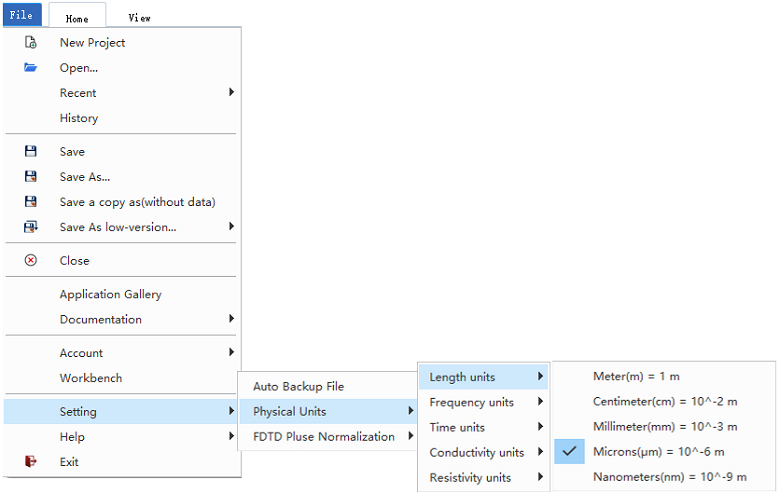Products
Solvers
Learning Center
Application Gallery
Knowledge Base
Support
License Agreement
Release Notes
Update and New
English
中文
Contact Number
+86-13776637985
Email
info@simworks.net
 Enterprise WeChat
Enterprise WeChat WeChat Service Account
WeChat Service Account
This section describes physical quantities and their units involved in the software.
Any physical quantity is composed of a numerical value and a unit.
Based on the International System of Units (SI), and considering the unit scale characteristics of micro-nano optoelectronics, the software establishes a more commonly-used unit system as the default setting, which allows users to adjust the unit of each physical quantity individually.
Understanding the unit system used in the software facilitates the selection of appropriate units for specific physical quantities.
For the definitions of the basic quantities, the definitions specified in the SI unit system shall apply:
| Name | Symbol | Show Symbol | Unit | Dimension |
|---|---|---|---|---|
| Length | l | Meter, m | ||
| Quality | m | Kilogram, Kg | ||
| Time | t | Second, s | ||
| Current | I | Ampere, A | ||
| Temperature | T | Kelvin, K | ||
| Amount of substance | n | Mole, mol | ||
| Luminous intensity | Iv | Candela, cd |
This software also specifies additional basic physical quantities based on specific needs, including:
| Name | Symbol | Show Symbol | Unit | Dimension |
|---|---|---|---|---|
| Frequency | f | |||
| Wavelength | lambda/wavelength | |||
| Conductance | S | |||
| Resistance | R |
For the definition of an electromagnetic field, the associated spatial dimensions vary by domain. Here are the common examples:
In addition, Fourier transform also involves the spatial angular frequency domain, etc.
| Name | Symbol | Show Symbol | Unit | Dimension |
|---|---|---|---|---|
| Electric intensity | E | V/m | ||
| Magnetic intensity | H | A/m | ||
| Poynting vector | P | W/m^2 | ||
| (Average) power | power | power | W | |
| Transmissivity | T | ~ |
The software allows users to change the units of length, frequency, time, conductance, and resistance according to different scales, specifically as follows:
The software supports the following length units:
| Name | Symbol | Show Symbol | Unit |
|---|---|---|---|
| Meter | m | meter | |
| Centimeter | cm | 1 Centimeter = 10^-2 meter | |
| Millimeter | mm | 1 Millimeter = 10^-3 meter | |
| Micrometer | um | 1 Micrometer = 10^-6 meter | |
| Nanometer | nm | 1 Nanometer = 10^-9 meter |
The software supports the following frequency units:
| Name | Symbol | Show Symbol | Unit |
|---|---|---|---|
| Hertz | Hz | Hertz | |
| Kilohertz | KHz | 1 Kilohertz = 10^3 Hertz | |
| Megahertz | MHz | 1 Megahertz = 10^6 Hertz | |
| Gigahertz | GHz | 1 Gigahertz = 10^9 Hertz | |
| Terahertz | THz | 1 Terahertz = 10^12 Hertz |
The software supports the following time units:
| Name | Symbol | Show Symbol | Unit |
|---|---|---|---|
| Seconds | s | Seconds | |
| Milliseconds | ms | 1 Milliseconds = 10^-3 Seconds | |
| Nanoseconds | ns | 1 Nanoseconds = 10^-9 Seconds | |
| Picoseconds | ps | 1 Picoseconds = 10^-12 Seconds | |
| Femtoseconds | fs | 1 Femtoseconds = 10^-15 Seconds |
The software supports the following conductance units:
| Name | Symbol | Show Symbol | Unit |
|---|---|---|---|
| Siemens | S | Siemens | |
| Millisiemens | mS | 1 Millisiemens = 10^-3 Siemens | |
| Microsiemens | uS | 1 Microsiemens = 10^-6 Siemens |
The software supports the following resistance units:
| Name | Symbol | Show Symbol | Unit |
|---|---|---|---|
| Ohms | ohm | Ohms | |
| Milliohms | mohm | 1 Milliohms = 10^-3 Ohms | |
| Microohms | uohm | 1 Microohms = 10^-6 Ohms |
The software supports the following physical constants:
| Symbol | Command | Parameter Value | Unit | Dimension | Description |
|---|---|---|---|---|---|
| pi | 3.14159265359 | 1 | The number | ||
| c | 2.99792458e8 | The speed of light in a vacuum | |||
| eps0 | 8.8541878128e-12 | The permittivity of free space | |||
| mu0 | 1.25663706212e-6 | The permeability of free space | |||
| h | 6.62607015e-34 | The Planck constant | |||
| hbar | 1.054571800e-34 | The reduced Planck constant | |||
| e | 1.602176634e-19 | The electron charge |
The software allows users to change the units of length, frequency, time, conductance, and resistance according to different scales, specifically as follows:

The software supports unit conversion for input data.
| Name | Symbol | Show Symbol | Unit |
|---|---|---|---|
| frequency | f | frequency | |
| wavelength | lambda | metre |
| Character | Description |
|---|---|
| inf | Infinity |
| nan | Not a number |
| -0 | Negative zero |
Automatic modification
Intelligent warning
Warning, modification
For units in scripts, particular attention should be paid to the following:
Special notes: